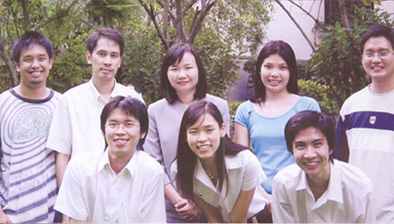|
Dr. Pimchai Chaiyen was born 25 December 1970 in Phuket, Thailand. She is the elder
daughter of Mr. Adul and Mrs. Suiloo Chaiyen.
Dr. Chaiyen was a
recipient of a scholarship
from the Development
and Promotion of Science
and Technology Talent
Project (DPST) during
1985-1997. After finishing
high school education
at Hatyai Wittayalai
School (1985-1988),
she completed B.Sc.
in Chemistry (first
class honors) from Prince
of Songkla University
(1988-1992), and Ph.D.
in Biological Chemistry
from University of Michigan,
Ann Arbor, USA (1992-1997)
under supervision of
Professor David P. Ballou
and the late Professor
Vincent Massey.
Dr. Chaiyen has received
numerous awards and
honors including Dr.
Tap Nilaniti Outstanding
Graduate Award (1992),
the Chrisman Award for
outstanding Ph.D. candidate
from Department of Biological
Chemistry, University
of Michigan, (1995),
the Murphy Award for
outstanding publication
series from Department
of Biological Chemistry,
University of Michigan
(1998), and the L'oreal-Unesco
Fellowship for Woman
in Science in Thailand
(2003). Dr. Chaiyen
joined the Department
of Biochemistry,
Faculty of Science,
Mahidol University,
Bangkok in 1997, and
is currently Assistant
Professor in Biochemistry.
She is also member of
the Center
of Excellence in Protein
Structure and Function,
and active research
team led by Professor
M.R. Jisnuson Svasti at Faculty of Science,
Mahidol University.
The major goal of
Dr. Chaiyen's laboratory
is to understand at
the molecular level,
the biochemical and
biophysical concepts
underlying catalysis
of some selected enzymes,
especially those using
Vitamin B2 derivatives
(flavin) as cofactors.
Each enzyme system has
been investigated by
various techniques and
research methods. Particularly,
studies on thermodynamics
and pre-steady state
kinetics using stopped-flow
spectrometer coupled
with absorbance/fluorescence/luminescence
detection are their
major tools to elucidate
enzymatic reaction mechanisms.
Stuctural studies of
these enzymes have also
been carried out in
collaboration with Dr.
Jirundorn Yuvaniyama.
Currently, research
in her laboratory involves
flavoenzymes catalyzing
oxygenations of aromatic
compounds, bacterial
luciferase, pyranose
oxidase, and serine
hydroxymethyl transferase.
Flavoenzymes oxygenation
aromatic compounds are
enzymes in microbial
metabolism that degrade
stable aromatic compounds
into the resulting oxygenated
products that may be
assimilated readily
by bacteria. These oxygenase
enzymes permit the use
of microbes to remediate
environmental pollutants.
Dr. Chaiyen's research
group has isolated a
novel prototype of enzyme
in the class, p-hydroxyphenylacetate
hydroxylase (HPAH) from
Acinetobacter baumannii,
and showed that HPAH
is a two-protein component
enzyme consisting of
the reductase and oxygennase
component (Eur J Biochem
268, 5550-61). Both
components were cloned
and expressed in E.
coli system (BBA 1680,60-6).
This reductase-oxygenase
anzymatic feature has
not been well understood,
and is currently being
investigated by various
leading laboratories
in the field. Recently,
her research group (in
collaboration with Dr.
David P. Ballou) elucidated
reaction mechanisms
of the reductase component
(Biochemistry 44, in
press) and the oxygenase
component (manuscript
in preparation), and
is currently investigation
a mode by which an unstable
reduced flavin intermadiate
is transferred between
two components. Another
enzyme involved in the
degradation pathway
of aromatic compounds
studied in her laboratory
is 2-methyl-3hydroxypyridine-5-carboxylic
acid monooxygase. Recent
works have shown that
the enzyme catalyzes
reactions by using electrophilic
aromatic substitution
mechanism (Biochemistry
43,3933-43), and the
enzyme was crystallized
and diffracted at ~
2.3 A (Acta Cryst F61,
312-14).
Her research group
is also investigation
reaction mechanisms
of flavoenzymes (which
have significant potential
in biotechnological
applications), bacterial
luciferase (Lux) and
pyranose oxidase (P2O).
Lux is a flavin-utilizing
enzyme that catalyzes
the oxygenation reaction
with concomitant release
of photon and has been
widely used in diagnostic
and detection applications.
Dr. Chaiyen's research
group has isolated two
novel Luxes from luminous
bacteria found in Thailand,
cloned and expressed
these enzymes in E.
coli system. Stopped-flow
studies of Lux reaction
are currently being
carried out in collaboration
with Dr. David P. Ballou.
Pyranose oxidase (P2O)
is an FAD-linked enzyme.
Studies of P2O in Dr.
Chaiyen's laboratory
were originated through
collaboration with Professor
Dietmar Haltrich, Vienna,
Austria. The enzyme
has gained considerable
industrial interest
since it converts various
sugars into their corresponding
2-keto-sugars, leading
to chiral synthesis
of valuable compounds
including D-tagatose,
a low-calorie sweetener.
Reduction potentials
of both wildtype and
mutant P2O were determined,
and reduction kinetics
is currently being investigated.
Besides
flavoenzymes, her laboratory is also studying the reaction of serine
hydroxyl-methyl transferase (SHMT) from Plasmodium vivax in
collaboration with Dr. Ubolsree Leartsakulpanich (BIOTEC). SHMT has
great potential of being a novel drug-target for antimalarial
chemotherapy, and was cloned and expressed by Dr. Leartsakulpanich. The
enzymatic assay was developed, and the reaction is currently being
investgated on kinetic and thermodynamic parameters.

|

